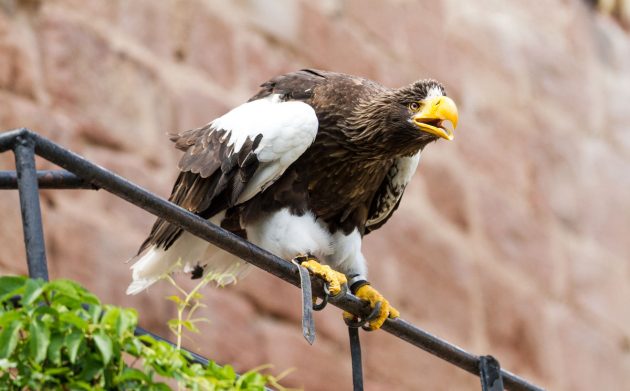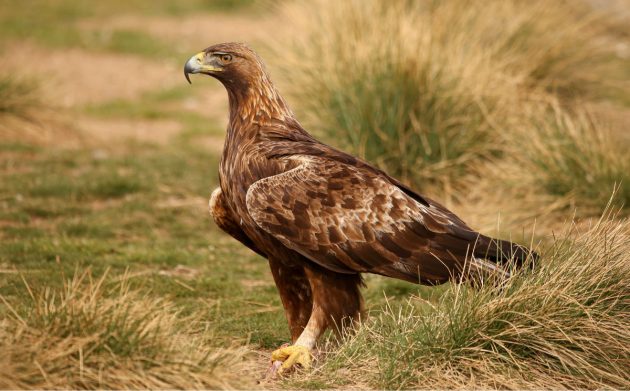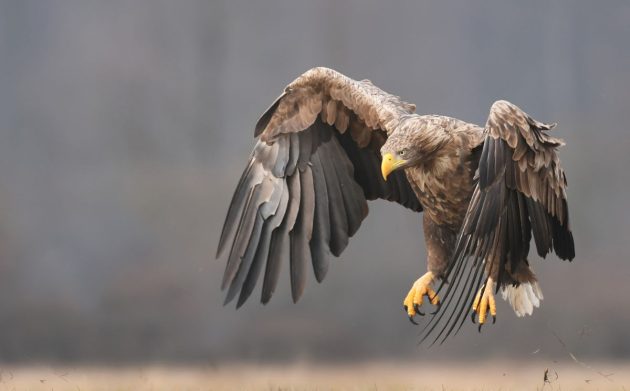By Amelia Caldwell
Amelia Caldwell, an avid bird enthusiast and the founder of Birdie Learning, has been captivated by the enchanting melodies of birdsong since childhood. This early fascination evolved into a lifelong passion for understanding avian wonders, inspiring her to create a platform dedicated to fellow bird lovers. Through Birdie Learning, Amelia shares her joy and knowledge of birdwatching, fostering a community where both novice and experienced birdwatchers can explore, learn, celebrate, and protect nature’s diversity.
Spotting an eagle in Alaska? It’s like finding the crown jewel of wildlife sightings. Up here, it’s not just about seeing a bird; it’s about feeling the raw, untamed spirit of one of America’s last wild frontiers.
Among the sprawling landscapes and untouched wilderness, you’ll find some of the most awe-inspiring birds of prey on the planet.
Let’s dive into the ultimate guide to spotting these magnificent creatures in Alaska. From the iconic Bald Eagle to the elusive Steller’s Sea-Eagle, the grand White-tailed Eagle, and the noble Golden Eagle, we’ll cover everything you need to know.
Note, this list is based on the eagles provided by the official list provided by the University of Alaska Museum Department of Ornithology. It is recent as of 2024.
- Bald Eagle
- Species Name: Haliaeetus leucocephalus.
- Body Length: 27.5 to 40 inches (70 to 102 centimeters).
- Wingspan: 5.9 to 7.5 feet (1.8 to 2.3 meters).
- Weight: 6.6 to 13.9 pounds (3 to 6.3 kilograms).
- Range: Most of Canada, Alaska, All of the contiguous United States, and Northern Mexico.
- Status In Alaska: Breeding resident.
- Conservation Status: Least Concern.
When you think “Alaska wildlife,” the Bald Eagle probably flies right into your mind. Known for its striking white head and tail against a dark brown body, this bird is the face of American freedom and a testament to conservation success.
You’ll typically spot these majestic creatures near marine zones and river valleys, where they feast on fish and scavenge.
Their nests, or “eagle mansions,” are massive stick constructions often reused and expanded each year.
Adult Bald Eagles are easy to recognize with their white heads and tails, while juveniles sport a mix of brown and white until they mature around five years old.
Easy To Spot Characteristics:
- Size and Build: Large with a wingspan ranging from 6 to 8 feet.
- Nesting Sites: High in large trees or cliffs overlooking water.
- Call: A high-pitched, weak-sounding whinny – surprisingly unmajestic for such a grand bird.
These eagles are year-round residents of Alaska, especially abundant in Southeast regions and along major river corridors. Your best bet to see them? During the salmon runs in summer when they gather en masse for the fishy feast.
Despite once being endangered due to hunting and pesticides, Bald Eagles have made a remarkable comeback, getting delisted from the U.S. Endangered Species list in 2007. Alaska has played a significant role in their recovery, boasting robust and stable populations.
2. Steller’s Sea-Eagle

- Species Name: Haliaeetus pelagicus.
- Body Length: 27.5 to 40 inches (70 to 102 centimeters).
- Wingspan: 6.5 to 8.2 feet (1.95 to 2.50 meters).
- Weight: 14 to 21 pounds (6.4 to 9.5 kilograms).
- Range: Steller’s sea eagles are endemic to coastal northeastern Asia, inhabiting regions in Russia, Korea, Japan, mainland China, and Taiwan. They are rare visitors to Alaska.
- Where to Find in Alaska: One individual has been journeying across North America, first spotted on August 30, 2020, near Denali National Park in Alaska.
- Status in Alaska: In Alaska, Steller’s sea eagles are considered vagrants, meaning they are occasional visitors rather than resident breeding birds.
- Conservation Status: Vulnerable.
Let’s talk about the heavyweight champion of eagles – the Steller’s Sea-Eagle. Native to the wilds of eastern Russia, this bird isn’t just big; it’s a flying behemoth.
Imagine an eagle that tips the scales at up to 21 pounds with an 8-foot wingspan. Yeah, even the Bald Eagle has to look up to this guy.
You’ll know you’re in the presence of a Steller’s Sea-Eagle when you see that vibrant yellow beak and the dramatic black-and-white plumage that looks like it was painted by a very enthusiastic artist. It’s like someone took a giant brush and decided to give the bird a makeover with a splash of white paint.
Easy to Spot Characteristics:
- Size and Build: One of the largest eagles on the planet with a wingspan stretching from 6 to over 8 feet.
- Plumage: Striking black and white colors that make it stand out.
- Habitat: Prefers remote coastal areas near large bodies of water like seas, lakes, or rivers.
In Alaska, the Steller’s Sea-Eagle is like that rare celebrity sighting – not common, but when it happens, it’s headline news. These majestic birds occasionally grace the coastal regions with their presence, turning any ordinary bird-watching trip into a memorable adventure. Spotting one is like hitting the birdwatcher’s jackpot.
These eagles are master fishers, using their powerful talons and spicules (tiny spikes on their feet) to grip slippery fish.
However, despite their might, Steller’s Sea-Eagles face significant challenges. Habitat loss and climate change threaten their populations, pushing these magnificent birds towards a vulnerable status. Conservation efforts are crucial to ensure that future generations get to experience the awe of seeing these incredible eagles soaring through the skies.
3. Golden Eagle

- Species Name: Aquila chrysaetos.
- Body Length: 27.5 to 40 inches (70 to 102 centimeters).
- Wingspan: 5.9 to 7.5 feet (1.8 to 2.3 meters).
- Weight: 6.6 to 13.9 pounds (3 to 6.3 kilograms).
- Range: Golden eagles are the most widely distributed species of eagle, inhabiting Eurasia, North America, and parts of North Africa.
- Where to Find in Alaska: Golden eagles can be found throughout Alaska, especially near large bodies of open water, cliffs, and mountainous regions. They often nest in high places, like cliffs and rock ledges.
- Status in Alaska: Breeding Residents.
- Conservation Status: Least Concern.
Encountering a Golden Eagle in Alaska is like finding a hidden gem in the vast wilderness. These birds are the epitome of elusive elegance, thriving in the open expanses and rugged mountains that define this wild state.
Picture this: a majestic bird with a dark brown body and a golden-brown nape that glows in the sunlight. That’s your Golden Eagle. While not as frequently spotted as its bald-headed cousin, the Golden Eagle holds its own mystique. Juveniles flaunt a mix of white and brown feathers, which gradually darken as they age – kind of like nature’s way of saying, “I get better with time.”
These eagles are versatile predators, the ninjas of the sky, capable of snatching up prey ranging from rabbits to deer. Yes, deer. Known for their incredible agility, they can swoop down at breathtaking speeds to catch their dinner.
Their nests are grand, high-altitude stick fortresses often perched on cliff faces, reused and expanded year after year.
Easy to Spot Characteristics:
- Wingspan: Ranges from 6 to 7.5 feet, perfect for their hunting prowess.
- Flight Pattern: Look for a slight V-shape in their wings while soaring – a dead giveaway even from afar.
In Alaska, your best bet to spot these aerial marvels is in places like Denali National Park and the Yukon-Charley Rivers National Preserve, especially between March and October.
Watching a Golden Eagle in its natural habitat, gliding with grace and dominating the skies, is an experience that leaves you awestruck. It’s a raw, unfiltered glimpse into the beauty and power of one of nature’s most formidable aviators.
4. White-Tailed Eagle

- Species Name: Haliaeetus albicilla.
- Body Length: 27.5 to 40 inches (70 to 102 centimeters).
- Wingspan: Up to 8.2 feet (2.5 meters).
- Weight: 11 to 15.4 pounds (5 to 7 kilograms).
- Range: Widely distributed across temperate Eurasia, breeding as far west as Greenland and Iceland, and stretching eastward to Hokkaido, Japan.
- Where to Find in Alaska: While not commonly found in Alaska, they occasionally pop up as vagrants.
- Status in Alaska: White-tailed eagles are not native to Alaska but are occasionally seen there during their wanderings. Thus, they are considered vagrants.
- Conservation Status: Least Concern
Known for their impressive size and strikingly white tail, White-tailed Eagles are the epitome of untamed beauty.
Though often a rare sight, when these magnificent birds do grace the Alaskan skies, they bring a deserved thrill to bird watchers.
The White-tailed eagle has a dark brown body, a strikingly paler head, and that signature white tail. Add in the fierce yellow beaks and talons, and you’ve got a bird that looks ready to dominate the skies.
Juveniles, on the other hand, sport a more understated brown plumage speckled with white, which gradually morphs into their adult splendor as they age.
These eagles are built like the bodybuilders of the bird world. Their robust build and powerful flight make them masters of navigating the expansive and harsh Alaskan wilderness. Their diet is as versatile as it gets – ranging from fish to small mammals and even larger prey like deer.
These apex predators know how to keep things interesting.
Easy to Spot Characteristics:
- Tail: The stark white tail is like a beacon, unmistakable even from a distance.
- Size: With a wingspan reaching up to 8 feet, they’re among the largest eagles around.
- Habitat: Preferring coastal areas and large water bodies, spotting them might require a bit of adventure into Alaska’s more secluded regions.
White-tailed Eagles are often seen either soaring high in the sky or perched majestically in tall trees or cliffs. Their nests are typically located in lofty trees near water bodies, where they have easy access to their favorite meal – fish. And if you’re lucky, you might hear their distinctive krick-rick-rick call, a sound that’ll become an unforgettable part of your Alaskan wilderness experience.
While these majestic birds are more commonly found in Eurasia, their occasional presence in Alaska underscores the global connections in our ecosystems and the shared responsibility we have in conserving such splendid creatures. So next time you venture into Alaska’s remote areas like the Aleutian Islands or Kodiak, keep an eye out for the awe-inspiring White-tailed Eagle. It’s an encounter you won’t soon forget.
Top Spots for Eagle Watching in Alaska
Here’s a guide to some of the best spots where you can catch these incredible birds in action.
Chilkat Bald Eagle Preserve
Let’s start with the rock concert of eagle gatherings: Chilkat Bald Eagle Preserve. From October to February, over 3,000 eagles flock here to feast on spawning chum salmon. Imagine an all-you-can-eat buffet, but for eagles. The Haines Highway offers excellent vantage points, complete with spotting scopes and interpretive displays – they might as well hand out binoculars and popcorn.
Denali National Park
Next up is Denali National Park, where you can enjoy some eagle spotting along the scenic park road. It’s like a wildlife documentary, but you’re the star viewer.
Kenai Fjords National Park
For coastal vibes, head to Kenai Fjords National Park. The coastal and river environments here are prime real estate for bald eagles, especially during the salmon runs from July to September. Think beachfront condos, but with more feathers and fish.
Glacier Bay National Park
Glacier Bay National Park is another must-visit. This place is like a five-star resort for bald eagles, particularly along bays and rivers. The park’s diverse ecosystems also support Kittlitz’s murrelets, which means eagles have plenty to snack on. It’s a raptor’s dream come true.
Juneau Mendenhall Wetlands
Year-round eagle watching? Yes, please! The Juneau Mendenhall Wetlands offer just that. As a crucial stopover for migratory birds, these wetlands are a raptor hotspot, including our beloved eagles.
Copper River Delta
Renowned for bird watching, the sprawling Copper River Delta provides ample feeding grounds for eagles, especially during the salmon spawning seasons.
Katmai National Park
Last but not least, Katmai National Park supports large populations of bald eagles thanks to its rich water bodies and abundant food sources. This place is an eagle paradise, perfect for those who want to see these birds in their natural element.
Eagle Watching Tips and Best Practices
Ready to embark on an eagle-watching adventure in Alaska? Here’s your guide to making the most of it, complete with some insider tips.
Essential Gear to Bring
To start, pack the right gear. Binoculars or a spotting scope are must-haves to observe eagles without disturbing them. Layered clothing is crucial because Alaskan weather likes to keep you guessing. And, of course, bring a camera to capture those majestic wing stretches and dramatic dives.
Optimal Times for Viewing
Timing is everything. Plan your eagle-watching escapades for early morning or late afternoon when eagles are most active.
Identifying Eagle Behaviors
Understanding their behaviors can turn a good viewing experience into a great one. Look for soaring, perching, and fishing activities.
Respect Wildlife and Habitat
Always respect the wildlife and their habitat. Maintain a respectful distance from eagles and their nests. This isn’t just about safety (yours and theirs), but also about letting them do their eagle thing without human interference.
Ideal Seasons
Winter months often offer the best eagle-watching opportunities, especially near open water sources where eagles gather to feed.
Source link
Facebook
Pinterest
Twitter
LinkedIn

